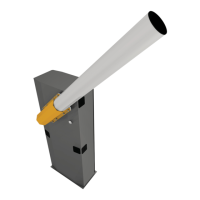
Do you have a question about the CAME G5000 and is the answer not in the manual?
| Protection rating | IP54 |
|---|---|
| Weight | 11 kg |
| Operating Voltage | 230 V AC |
| Power supply | 230V AC |
| Operating temperature | -20°C to +55°C |
Details about the manufacturer, Came S.p.a., including address and contact information.
Lists EU directives and harmonized standards the automatic barrier complies with.
Crucial safety guidelines for installers to follow before, during, and after installation.
Guidance on selecting suitable installation locations, handling heavy parts, and site demarcation.
Ensuring residual risks are communicated via pictograms and user training.
Details the barrier's construction and its specific application in parking facilities.
Provides key technical specifications, operating limits, and physical dimensions of the G5000.
Lists and identifies the main components of the barrier system.
Illustrates a typical installation setup with numbered components.
Details required cable types, minimum thicknesses, and compliance standards for electrical connections.
Lists essential tools and materials needed for a safe and compliant installation.
Instructions for digging a hole, setting up tubes, and preparing the foundation for the anchoring plate.
Steps for placing the plate, pouring concrete, and allowing it to solidify.
Guidelines for safely transporting, positioning, and fastening the barrier cabinet.
Procedures for checking connections and hatches before final assembly.
Detailed steps to reverse the barrier's opening mechanism for right-hand installation.
Instructions for setting mechanical stops and inverting gearmotor phase for correct operation.
How to securely fasten the barrier cabinet onto the anchoring plate.
Guidance on calculating boom length and attaching it to the drive shaft.
Explains how to adjust the barrier's balance using springs based on boom type and passage width.
Provides specific spring configurations (A, B) for various boom models and passage clearances.
Steps to manually adjust spring tension for proper boom stabilization at 45°.
Ensuring correct spring operation and recommending lubrication after balancing.
Lists fuse ratings for different connections on the control board.
Identifies and describes the various parts and connectors on the control panel.
Instructions on connecting wires and cables, using cable glands, and avoiding contact with hot parts.
Details the pre-connected gearmotor wiring and configuration for right-hand installation.
Details the power output for accessories and the use of buffer batteries.
Explains outputs for luminous cords, flashing lights, and status notification lights.
Instructions for connecting transponder readers, keypads, stop buttons, and antennas.
Guidance on fitting AF, R800, and R700 decoding cards for enhanced functionality.
Details programming options (C1-C9) for photocell behavior during opening and closing.
Explains the automatic safety test for photocells and error reporting (Er4).
Enables energy saving for photocells when the system is in stand-by.
Instructions for connecting systems for paired, alternate, or Came Remote Protocol operations.
How to adjust the boom's vertical travel using jointed arm and counter nuts.
Steps to set the mechanical limit-switch stop for boom's horizontal travel.
Explains the function of the ESC, ENTER, <, and > buttons for navigating menus.
Details essential functions like Total Stop, Input configuration, and Safety Test.
Covers obstruction detection, encoder, and barrier state notification outputs.
Details functions for luminous cords, additional light, automatic closing, pre-flashing, operating time, and speed adjustments.
Adjustments for closing slow-down speed, calibration, travel sensitivity, and slow-down sensitivity.
Functions for serial connection, saving/reading data, paired mode, peripheral number, and sleep mode.
Settings for COM speed, user entry, deletion, and parameter transfer.
Configuration for boom type, motor test, travel calibration, and maneuver count.
Steps to perform a motor test to check the direction of travel and invert phases if necessary.
Instructions for calibrating the barrier's opening and closing travel limits.
Procedure for entering new users and associating commands like open-close or pedestrian access.
Steps for deleting individual users from the system's memory.
Instructions for saving and uploading system data and configuration using a memory roll.
Procedures for final checks, reconnecting the earth cable, and closing the inspection hatch.
Lists common error messages (Er1-Er8, C0, C1/C4/C5/C9) and their meanings.
Provides a table of common problems, their references, and checks for resolution.
Steps for connecting panels, safety devices, and activating functions for alternate operation.
Explains commands (ONLY OPEN, PARTIAL/PEDESTRIAN, STEP-STEP) for alternate barrier control.
Instructions for connecting panels, safety devices, and deactivating functions for paired operation.
Describes operating modes where both booms open or only the master barrier opens.
Information on CAME's Environmental Management System and commitment to safeguarding the environment.
Guidelines for disposing of packaging and product components responsibly and in compliance with laws.